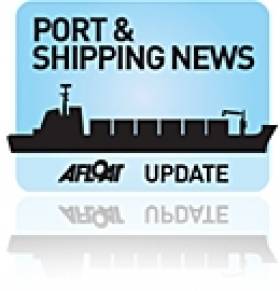Displaying items by tag: Cargoship Focus
#CargoshipFocus: Corrib Shipping, a Dublin based ship management company, whose Cathma, one of four cargsoships, is at anchor offshore of Cork Harbour this morning awaiting orders, writes Jehan Ashmore.
The 3,990 gross tonnage Cathma, flagged in Curacao a Dutch island in the Caribbean, had sailed light yesterday from Foynes Port. The cargoship having discharged a cargo of fertiliser from Ventspils, Latvia.
Cathma had taken almost a week to complete the voyage from the Baltic to the Shannon Estuary port, one of six terminals operated by Shannon Foynes Port Company.
Along with her fleetmates, Cathma sails for Corrib Shipping based in Dundrum, Co. Dublin. Founded in 1995, Corrib comprises shipowning companies and employs officers and crew to man its vessels.
Cargsoships of Corrib sail as part of the Royal Wagenborg fleet, in which the Dutch shipping operator (alone has 170 plus vessels) act as chartering agents for the Irish company.
The other members of the Corrib dry cargsoship carrier quartet are Cora Jo, Jolyn and Cathy Jo. The latter vessel likewise of Cathma were built by Ferus Smit’s yard in Leer, Germany.
The shipbuilder's Dutch yard in Westerbroek is where Arklow Shipping Nederland B.V. had their first of 10 ‘C’ class leadships, Arklow Cadet launched in June.
#Arklow'V'sisters – Runcorn's record freight in 2014 as previously reported on Afloat.ie, referred to a call to the dock port by Arklow Viking to load salt for Spain, it is understood she is currently in neighbouring Portugal, writes Jehan Ashmore.
Arklow Viking is one of a trio of Arklow Shipping 'V' class 4,950 total dwt cargoships managed by Dutch subsidiary, Arklow Shipping N.V.
Her Portuguese port of call is Ribdeo, having taken a passage through the Bay of Biscay that involved rounding Galicia on Spain's north-western coast from a departure in Lisbon.
Also today, Arklow Venture which had berthed along Cork's City south quays had also sailed from an Iberian port, Musel Arnao. This afternoon she departed the Port of Cork for the short-sea coastal passage off the Cork and Kerry peninsula's and is bound for Foynes on the Shannon Estuary.
While earlier this week on Tuesday, Arklow Venus arrived to Dublin Graving Docks Ltd. The 90m long vessel had made the short sea passage in ballast from Avonmouth Docks.
On arrival at the Irish port, she initially moored along the Lead-In East Jetty within Alexandra Basin before entering the dry dock. The marine engineering business carries out repairs, maintenance and overhauls.
It is understood Arklow Venus is to remain in the graving dock until early next month and follows last year's call of Arklow Viking, for her third special survey.
The 200m long dry-dock is the only such facility in the port. The graving dock chamber can cater for two ships simultaneously or one larger vessel.
As previously reported on Afloat.ie, DGD potentially faces closure as the Dublin Port Company plan to redevelop Alexandra Basin by re-using the dry-dock site to provide more quayside cargo space.
On a related note to space and that of cargo volumes, the ASL fleet carry cargoes varying from peat-moss to animal feed and fertiliser. The 'V' class sisters for examples can handle a hold grain-bale capacity of 198762 ft³/5628 m³.
The Dutch flagged trio were all built by Pattje Shipyard B.V., Netherlands, where the yard launched the 'Venus' in 2000, however her sisters both date to 1999.
This pair having been completed before the millennium stand-out, compared to the rest of the 44 cargoships (up to 34,905dwt) to date that were all were built since 2000.
The order for six 'B' class 8,660dwt newbuilds is nearing completion as the fifth in the series, Arklow Brave was launched in mid-December 2014. She was expected to be delivered to her owners this month.
























